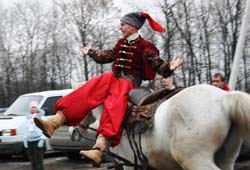Is it possible to make history fashionable?
Festival near Kyiv showcases Cossack-era entertainments
A couple of weekends ago admirers of the Cossack history, folk songs, and Ukrainian dishes gathered in a suburb of Kyiv. The Etnozyma-Hetmanski Hostyny Festival (Ethnic Winter: Visit from the Hetman), which gathered guests from all over Ukraine, is the sixth in a series of similarly-themed ethnic festivals. The highlight of the event was a performance by the Skif Equestrian Theater. The Kalyna Folk Dance Group raised the visitors’ spirits, and those who look for extreme thrills were charmed by the fire show.
The organizers dedicated the festival held at the Hetman’s Fortress Art and Entertainment Complex (now renamed the Hetman’s Residence) to the 360th anniversary of the beginning of the Ukrainian liberation movement headed by Hetman Bohdan Khmelnytsky.
“In early 1648 Khmelnytsky left this very place to defend his state, and by the end of the year he returned to Kyiv as a national hero,” said Mykola Tomenko, the initiator of the festival. “Khmelnytsky’s triumphant arrival in Kyiv was the culmination of the Ukrainian people’s consolidation around the national idea. He passed this very way.”
This confidence is not shared by the historian Yurii Shapoval, who also attended the event. He considers the version of historical events propounded by the organizers of Etnozyma — that students, clergymen, and Ukrainian patriots met the hetman a few kilometers outside of Kyiv — to be invented. “This story is a kind of myth; nonetheless, myths play a positive role in history. This will serve as a very good example if this type of idea — to create cultural-artistic centers like this — is implemented in various Ukrainian regions. I have noticed that the organizers of the Hetman’s Fortress have a deep love for Ukraine and a taste for history,” Dr. Shapoval explained to The Day.
Historians may dispute the question of where Hetman Khmelnytsky was passing through. Meanwhile, the actor playing the role of the hetman, along with two Cossacks, approached the members of the audience and treated them to an equestrian show. All the roles were performed by actors from the Skif Theater.
The atmosphere became more enjoyable when Hetman Khmelnytsky suggested to his daring fellows to knock out sabers with a quirt, a three-meter long whip with a characteristic whine when it is snapped. At first glance, this is not a difficult task: to hold the sabers tightly you only have to have strong arms and not be scared that the quirt will hit your arm. A death-defying number was a performance of the Cossack game in which a blindfolded Cossack knocks off a hat from another Cossack’s head. The hat was knocked off, with Tomenko’s head still on his neck. This was the way the Cossacks used to entertain themselves in deadly earnest.
“The Cossacks used to do many things with a quirt. They would even use them to shoot with: there is a special attachment that is fastened to the end of the quirt and then it strikes like a bullet,” The Day was told by Oleh Burov, the trainer of the Skif Equestrian Theater, who played the role of Hetman Khmelnytsky. “You need a few years to learn how to do everything the right way. For the equestrian tricks some people need a week, others — several years. I trained with Zaporozhian Cossacks who came to Kyiv to teach us.”
Cookery was another revived tradition that was offered to the guests. The Cossack dishes were tasted mostly by the male guests (and women who had not been warmed up with the help of mulled wine). They tasted a Cossack horilka (vodka) called khrinovukha, which is distilled from horseradish and honey. The Cossacks would drink this alcohol before going into battle: its tonifying effect is strong that even Zaporozhian Cossacks who were ill got up on their feet and took up their weapons.
“I am discovering more and more of the ancient past thanks to this kind of festival, particularly Cossack cuisine,” said Oleksandr Bryhinets, one of the organizers of the event. “Once, during a festival in Cherkasy region, I was treated to a Cossack kulish, a kind of thick soup or gruel, cooked with fish. I was astonished by the use of fish in a kulish. The answer was: and what did Cossacks living on the banks of the Dnipro River eat?”
Etnozyma is the kind of event that some people in Ukraine are trying to turn into a vogue, especially museum employees, in order to attract visitors to their museums. This tradition, borrowed from the West, is based on dramatized recreations of historical events, usually on the sites of historical monuments. Many museums are going the multi-media route, offering screenings of films and slide-shows as well as folk music.
This is the goal of the organizers of a series of ethnic festivals that were launched in the summer of 2006 with a festival called “Ethnolito: The 19th Kupala Games in Gogol’s Fatherland” (subsequent festivals have taken place in Kachanivka, Bukovyna, Volyn (in Kolodiazhne), and the Sophiivka Landscape Park). All of them were dedicated to a particular historical topic.
The latest Etnozyma festival was called “The Cossack Face,” and in order for Ukrainians to remember their hetmans, plans are underway to create 16 more “hetman’s residences” in Ukraine.






